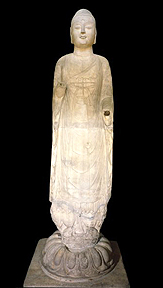
Sui dynasty (581-618 CE)
From Chongguang temple, Hancui village, Hebei, China
Dated 585 CE
Marble
Height: 5.8 m
Width: 2.03 m
Acquisition number: #OA 1938.7-15.1
Gift of the Chinese Government in memory
of the Chinese Exhibition in London 1935-36
Image courtesy of the British Museum (copyright reserved)
Emperor Wendi (reigned 581-604) and his successor Yangdi (reigned 604-618 CE) were both Buddhists, and encouraged the spread of the religion throughout the Sui Empire. They commissioned the creation of new images, and also provided imperial funding for the repair of existing icons neglected or damaged during the centuries of political struggle.
This image depicts Amitabha, Buddha of the Western "Pure Land" Paradise, and is believed to be one of those created with royal patronage. Originally it was paired with a standing bodhisattva, now in the collection of the Tokyo National Museum. An inscription on the bottom of the statue indicates that it was dedicated in the fifth year of Kaihung (585 CE) at Chongguang temple in Hancui village.1 The columnar shape of the figure and the relatively shallow relief of the garment folds are both qualities typical of Sui-era statuary.
(1) See the British Museum web page dedicated to this object.